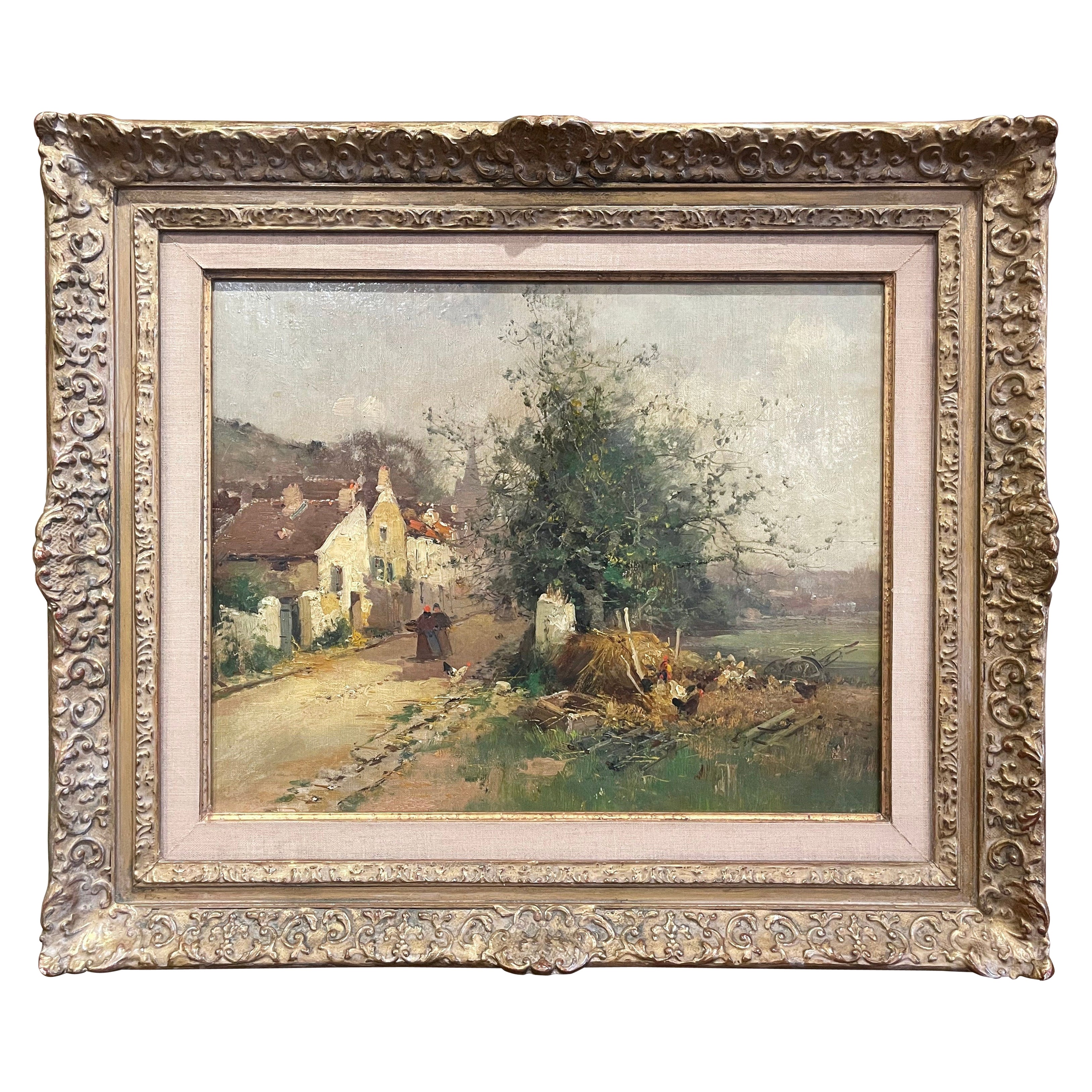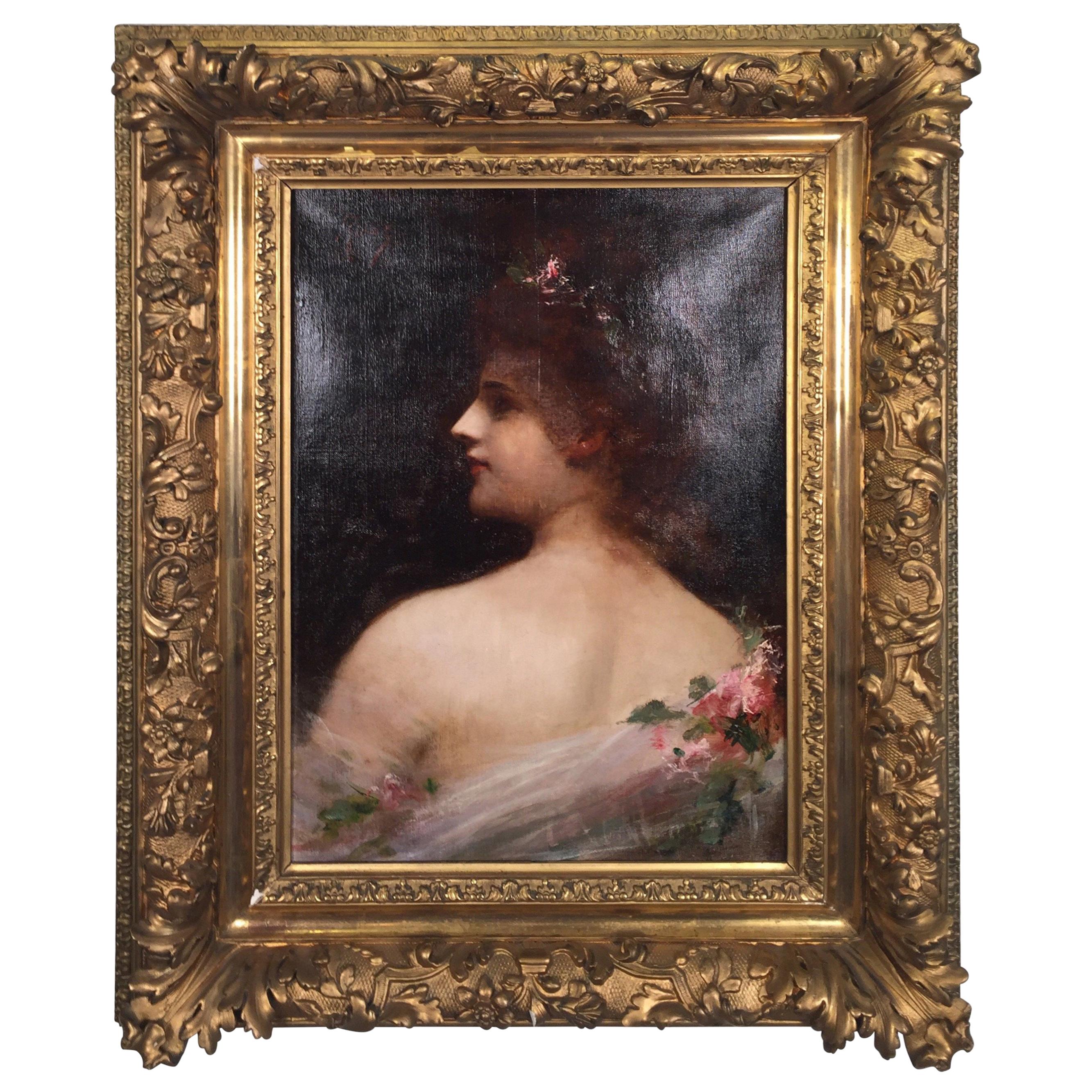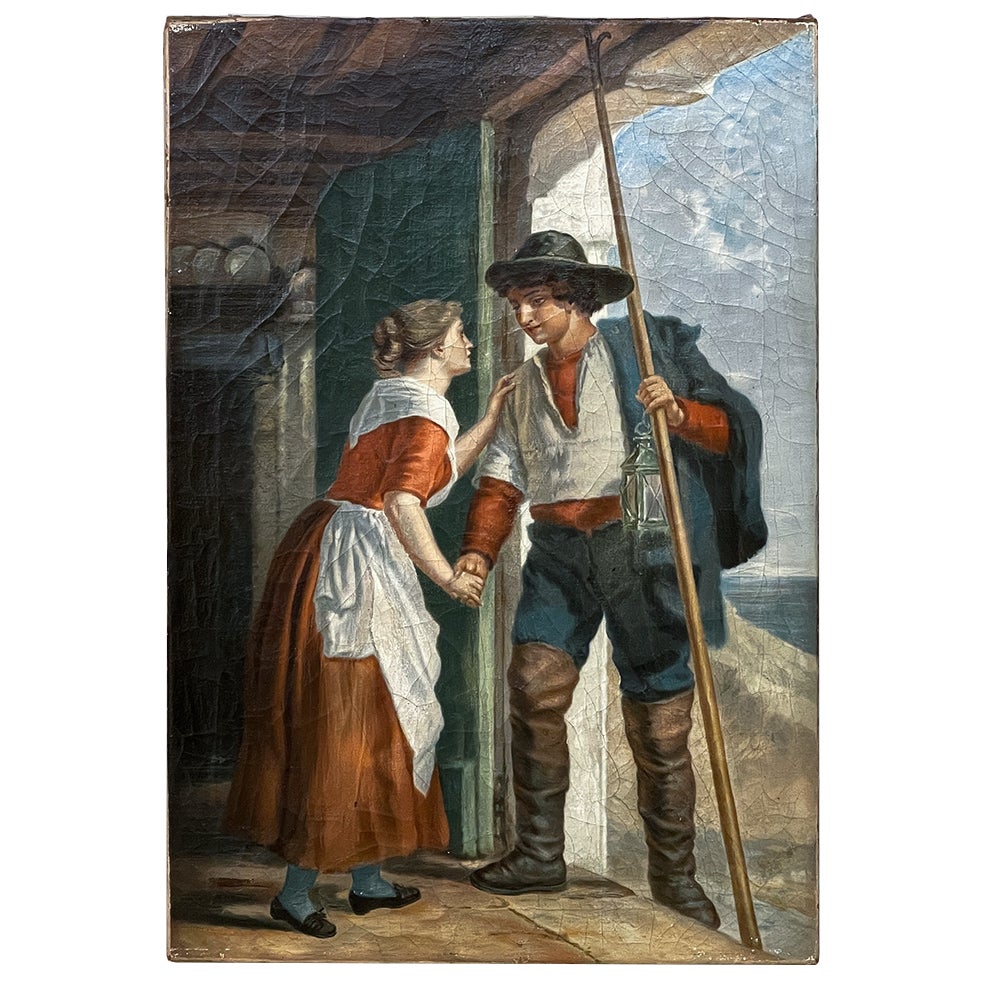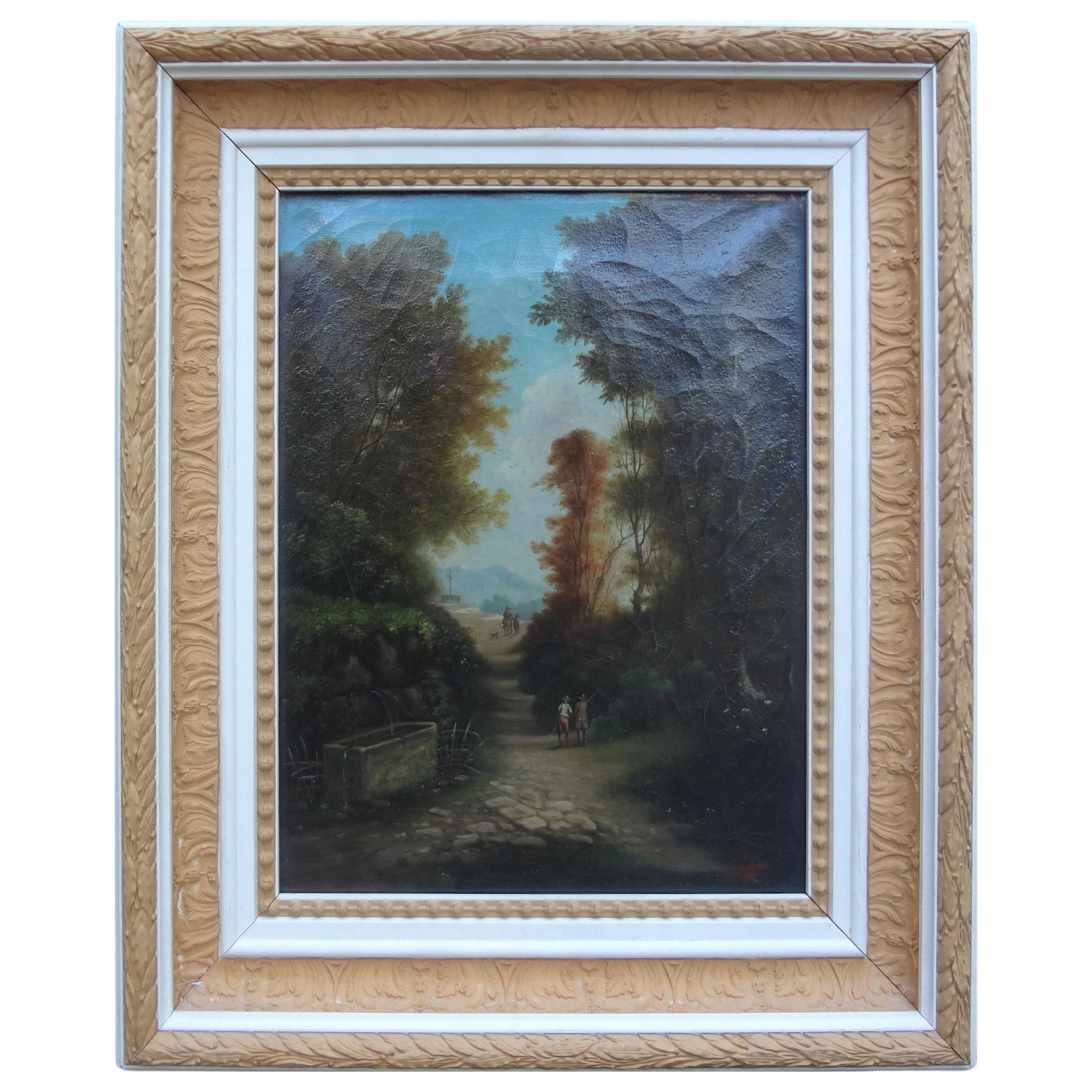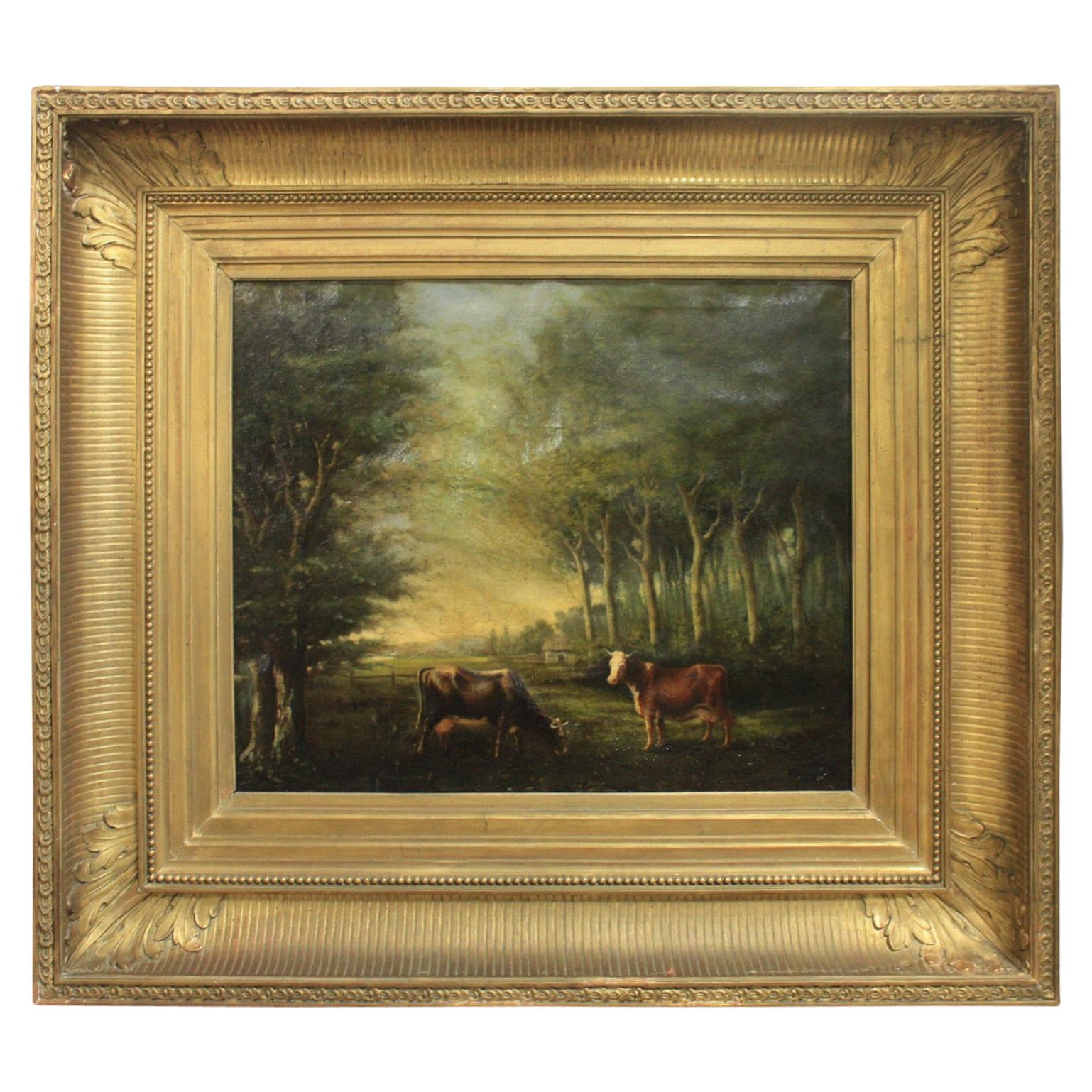Items Similar to 19th Century French Oil on Canvas Monk Painting Signed Jose Frappa
Video Loading
Want more images or videos?
Request additional images or videos from the seller
1 of 17
19th Century French Oil on Canvas Monk Painting Signed Jose Frappa
About the Item
Decorate a study or office with this joyful antique painting. Set in the original carved giltwood frame, the artwork, signed in the lower right corner by the artist, Jose Frappa, features a happy monk testing some fresh home made donuts known as "Pets de Nonne". (Nun's puffs, also known less euphemistically as nun's farts!). Le pet de nonne or le beignet goes back to the Renaissance period; different stories are told about the origin of the name but, in any case une nonne is a nun and pets de nonne were first of all cooked by nuns in Franche Comté ( east of France) for instance. The cheerful painting is very well executed with rich colors, and in excellent condition.
Jose Frappa (1854-1904). Born on April 18, 1854 to Rose and Jean-Claude Frappa in Saint Etienne near Lyon, Frappa grew up during the relatively stable Second Empire period when France was perceived as both a political and cultural leader in Europe. The family grocery store was apparently at the center of daily life in St. Etienne, and Frappa seems to be fondly remembered there even now. Frappa enrolled at the art school in 1872 when he was eighteen years old, the year after France’s resounding defeat at the hands of the Prussian army. Fortunately for the city of Lyon, the Prussian advance on Paris and Versailles was sufficient to end the war before hostilities spread further south. Despite the gravity of France’s occupation by Prussian forces, Lyon remained a thriving industrial center in the late nineteenth century; more significant for Frappa, it offered him an exciting introduction to metropolitan life. Within a year, Frappa had decided that he could make a career as a painter and moved to Paris to study at the national Ecole des Beaux-Arts there. According to an 1890 source, Frappa studied first with Isadore Pils (1813-1875), and then with Charles Comte (1823-1895) and Jehan-Georges Vibert (1840-1902) after Pils’ death in 1875. Both Comte and Vibert specialized in anecdotal genre paintings which were very popular during the early years of the Third Republic.
When Frappa made his Salon debut in 1876, anecdotal genre painting was amply displayed and widely appreciated by the public. According to Emile Zola’s review of the Salon that year, viewers stood in line to see The Flower Market by Marie-François Firmin-Girard (1838-1921), a charming depiction of beautiful women among the flower sellers next to the Seine. More influential for Frappa, however, was The Cardinal’s Antechamber, a painting by Vibert in which a red-robed cardinal addresses a lovely young woman seated in an opulent setting. Vibert was well known for this type of image, and undoubtedly mentored Frappa as he began to define his own artistic path. Four years later, he won an honorable mention at the 1880 Salon, no small achievement among a field of 7,289 entries, the largest number ever at the Paris Salon.
In his personal life, Frappa was also thriving. He married Madeleine Marie Augustine Frézet in 1881 and set up housekeeping with her in the 17th arrondissement on the northwest side of Paris. On April 3, 1881, their only son, Jean José Frappa was born. It was during these years that Frappa seems to have begun to develop his reputation as a portrait painter. The earliest securely dated portrait is from 1884 and shows a beautiful young woman in a sumptuously lace-trimmed gown. Known only as Portrait d’élégante, she was clearly a woman of style and presumably wealth. With a new family to support, Frappa undoubtedly realized that portrait painting could provide a reliable income if he was successful at it.
During the 1880s, he also began exhibiting his work in both London and the United States, expanding the market for his paintings beyond the borders of France. He held an exhibition in London in June 1887 and appears to have continued this practice well into the 1890s. Frappa was particularly active in the American art market, with representation through galleries in New York City. Although his work was probably quite widely appreciated in the United States, it is securely documented in the collection of William H. Shaw and in the catalogue of the Mark Hopkins Institute of Art in San Francisco. [ii] By 1888, Frappa was sufficiently affluent to move his family into new quarters at 12, rue de Pergolèse in the decidedly fashionable 16th arrondissement near the Bois de Boulogne.
Frappa’s prosperity depended in part on his ability to work in a variety of genres ranging from the amusing anecdotal scenes of religious figures, particularly cardinals and monks engaged in all too human foibles of enjoying a glass of wine or playing popular card games, to traditional portraiture to the occasional naturalistic depiction of more serious subjects. One such naturalistic painting is a large canvas, The Wet Nurse Agency, which depicts the unusual subject of mothers interviewing wet nurses for their newborn babies. This practice was widely encouraged in late nineteenth century France as part of a national campaign to ensure infant health and safety; perhaps Frappa was commissioned by one of the health-related government agencies to create this painting. What is clear in this canvas, however, is that Frappa was influenced by the Realist painters among his contemporaries in both England and France, especially the narrative works of Ford Madox Brown (1821-1893).
Public acclaim for Frappa’s work increased considerably in the late 1880s and 1890s. He was twice a member of the Conseil des 90 de la Société des Artistes Français, a private council that today might be called an executive committee; and an associate member of the newly created Société Nationale des Beaux-Arts led by Pierre Puvis de Chavannes. In 1890, he began exhibiting at the Salon du Champ de Mars that was associated with the Société. During this decade, Frappa was also exploring the world of publishing, both as an illustrator and as an author. His illustration entitled Fleur et Papillon was included in the limited edition publication of Chansons et Poesies de Camille Roy in 1898; and simultaneously, he was working on a book of his own on the subject of expression in the human face. Published by the Librairie générale des art décoratifs in 1902, Frappa’s book, Les expressions de la physionomie humaine, became a seminal book for analyzing how human beings could (or could not) control their facial expressions. This type of scientific inquiry was typical of the post-Darwinian world in which both artists and scientists sought to understand how humans fit into the scheme of biological development.
In 1897, Frappa was represented in the Exposition Internationale in Brussels with two paintings, Le dispensaire d’enfants (The Children’s Clinic) and La femme au manteau bleu (The Woman in the Blue Cloak). Although this world fair is remembered today for its introduction of art nouveau design as well as the colonial display of work from what was then the Belgian Congo, Frappa must have been actively involved in promoting the French arts section; he was awarded the Legion of Honor medal on February 4, 1898 in large part because of his work on the exposition.
After such a remarkable career, beginning in the family grocery story in St. Etienne and ultimately becoming a respected and successful painter in Paris, Frappa’s life ended rather early at age 50 in 1904. He did not live to see his son become a well-known author, playwright and editor of Le Monde Illustré. Frappa is buried not far from his home in the Boulogne-Billancourt cemetery. In his hometown of St. Etienne, he was honored with a large monument in front of the town hall. Sculpted by Georges Bareau, the dedication ceremony on Mary 17, 1912 was attended by the national minister of fine arts as well as the mayor of St. Etienne and of course, Frappa’s widow, son and mother.
Selected Museums
Kemper Art Museum, Washington University, St. Louis, Missouri
Musee d’art Moderne et Contemporain, Strasboug
Musée de l’Assistance Publique, Hôpitaux de Paris
Musée des Beaux-Arts, Lyon
Musée d’Orsay, Paris
Musée du Louvre, Paris
Northhampton Museums and Art Gallery, England
Listed in the Benezit (see last picture)
29.5"W x 34.5"H
- Creator:José Frappa (Artist)
- Dimensions:Height: 34.5 in (87.63 cm)Width: 29.5 in (74.93 cm)Depth: 3.5 in (8.89 cm)
- Materials and Techniques:
- Place of Origin:
- Period:
- Date of Manufacture:circa 1880
- Condition:Wear consistent with age and use.
- Seller Location:Dallas, TX
- Reference Number:
About the Seller
5.0
Platinum Seller
These expertly vetted sellers are 1stDibs' most experienced sellers and are rated highest by our customers.
Established in 1986
1stDibs seller since 2012
2,400 sales on 1stDibs
Typical response time: <1 hour
- ShippingRetrieving quote...Ships From: Dallas, TX
- Return PolicyA return for this item may be initiated within 3 days of delivery.
More From This SellerView All
- 19th Century French Village Oil Painting on Canvas Signed E. Galien-LaloueBy Eugene Galien-LaloueLocated in Dallas, TXThis 19th century impressionist painting was crafted in France, circa 1890. Set in a carved giltwood frame, the artwork painted on canvas, illustrates a picturesque, countryside landscape scene with people, chickens, a village and its road in the foreground. The oil on canvas is signed on the back in the lower left corner, Eugene Galien-Laloue (see last picture). There is also a printed version of the artist name in the top left corner, printed Galien-Laloue (see second to last picture). The artwork is in excellent condition with rich, sensational colors; it would make a lovely addition to a library, den, or living room. Canvas relined. We thank Mr. Noé Willer for confirming the authenticity of this work, which appears in his archives of the artist. Eugène Galien-Laloue (1854-1941) was a French artist of French-Italian parents. He was a popularizer of landscape and street scenes, usually those illustrating autumn or winter settings. His paintings of the early 1900s accurately represent the era in which he lived: a happy, bustling Paris during la Belle Époque. His paintings regularly include horse-drawn carriages, trolley cars and its first omnibuses. Galien-Laloue's works are valued not only for their contribution to 20th century art, but for the actual historical content which they document. His work can be seen at the Musée des Beaux-Arts, Louvier, Musée des Beaux-Arts, La Rochelle, Mulhouse, France. A typical Galien Laloue...Category
Antique Late 19th Century French Paintings
MaterialsCanvas, Giltwood
- 19th Century French Oil on Board Painting Signed H. D. LemaitreLocated in Dallas, TXPainted on board and dressed on in the original carved gilt frame, the artwork depict a pastoral and landscape scene with village in the background, in the post-impressionist manner....Category
Antique Late 19th Century French Paintings
MaterialsGiltwood
- 19th Century French Oil on Canvas Marine Painting Signed S. Audibert Dated 1885Located in Dallas, TXPainted circa 1885, the artwork on canvas is set in the original carved gilt wood frame; the scene illustrates the picturesque, ocean-front landscape of the "Port de Marseille", in ...Category
Antique Late 19th Century French Paintings
MaterialsCanvas, Giltwood
- 19th Century French Signed Oil on Canvas Painting in Carved Gilt FrameLocated in Dallas, TXHand painted in France circa 1880 and set in the original carved two-tone giltwood and blackened frame, the large art work depicts a table still life subject with grapes spilling out from a faience plate with a terracotta wine jug and a glass in the background. The colorful painting is in excellent condition with a variety of soft color palette inside, and signed in the bottom left corner (signature unreadable). Decorate a study or office with this elegant antique wall decor...Category
Antique Late 19th Century French Paintings
MaterialsCanvas, Giltwood
- 19th Century Oil on Canvas French Revolution Painting Signed and Dated 1849Located in Dallas, TXSet in the original carved giltwood frame, this antique oil on canvas was painted in France, circa 1849, the art work depicts two French soldiers in hard discussion with a man carryi...Category
Antique Mid-19th Century French Paintings
MaterialsCanvas, Giltwood
- 19th Century Oil on Canvas Painting "A Heavenly Recital" Signed J. BernsteinLocated in Dallas, TXSet in an exquisite carved gilt frame, the large antique painting was created in Germany, circa 1880, titled "a heavenly recital", the canvas depicts three jovial monks playing music...Category
Antique Late 19th Century German Paintings
MaterialsCanvas, Giltwood
You May Also Like
- 19th Century Spanish Oil on Canvas Painting Signed RianiLocated in Lambertville, NJOil on canvas portrait of a Spanish aristocratic lady. The painting of a young woman in profile with a dark background dressed in a formal gown with pink roses, signed by the artist ...Category
Antique 1890s Spanish Aesthetic Movement Paintings
MaterialsCanvas, Giltwood, Paint
- 19th Century Oil Painting on CanvasLocated in Dallas, TX19th century oil painting on canvas depicts a scene portrayed by a wide variety of artists over the years. A young couple are saying their g...Category
Antique 1880s French Aesthetic Movement Paintings
MaterialsCanvas
- 19th Century French Landscape Oil On Canvas, Signed PagesLocated in Houston, TX19th Century French Landscape Oil On Canvas Signed Pages. Here is a fine example of the work of Jules Eugene Pages. Dimensions of canva...Category
Antique Late 19th Century French Other Paintings
MaterialsCanvas, Wood
- French 19th Century Oil on CanvasLocated in Stockbridge, GAFrench 19th century oil on canvas.Category
Antique Mid-19th Century French Paintings
MaterialsCanvas
- 19th Century Oil on Canvas José Mirailles Darmanin Spanish SchoolBy Joseph DarmaninLocated in Marseille, FR19th century José Mirailles Darmanin (1850-1900) Spanish school the gentleman (and his servant) takes the meal. Genre scene.Category
Antique 19th Century French Paintings
MaterialsCanvas
- 19th Century Oil on Canvas French Signed and Dated Landscape Painting, 1899Located in Vicoforte, PiedmontLarge French painting dated 1899. Oil painting on canvas, first canvas, depicting a view of a country village with characters and animals of good...Category
Antique 1890s French Paintings
MaterialsCanvas
Recently Viewed
View AllMore Ways To Browse
Pierre Vibert
A Vibert
Post War French Furniture
Papillon Glass
Set Antique French Paintings Women
Brussels Sellers
Store Front Sign
19th Century Lyons France
Antique Grocery Furniture
Louis Glasser Paintings
French Republic
American Oil Paintings After World War Two
D If Type Ii A
Old World Religious Paintings
Fleur De List
17th Century New England
Antique Oil Painting Old Woman
Oil Paintings Colonial America
